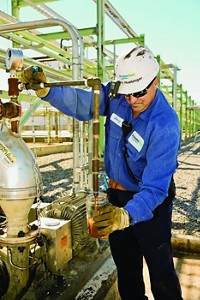Advertisement
Grab your lab coat. Let's get started
Welcome!
Welcome!
Create an account below to get 6 C&EN articles per month, receive newsletters and more - all free.
It seems this is your first time logging in online. Please enter the following information to continue.
As an ACS member you automatically get access to this site. All we need is few more details to create your reading experience.
Not you? Sign in with a different account.
Not you? Sign in with a different account.
ERROR 1
ERROR 1
ERROR 2
ERROR 2
ERROR 2
ERROR 2
ERROR 2
Password and Confirm password must match.
If you have an ACS member number, please enter it here so we can link this account to your membership. (optional)
ERROR 2
ACS values your privacy. By submitting your information, you are gaining access to C&EN and subscribing to our weekly newsletter. We use the information you provide to make your reading experience better, and we will never sell your data to third party members.
Business
Cleantech: New Funding Will Be Scarce, But Scale-Up Plans Continue
by Melody M. Bomgardner
January 14, 2013
| A version of this story appeared in
Volume 91, Issue 2

This year will be one of cleantech contradictions, industry watchers say. New technology start-ups will not be showered with venture capital funds, and existing firms will find it difficult to raise money with stock offerings. But some companies only a few years old will turn on commercial facilities in large numbers by year-end.
The money challenges will be a continuation of the lull in excitement that the sector experienced in 2012. Cleantech venture funding in the first three quarters of 2012 decreased 15% to just under $2.8 billion compared with the same period in 2011, according to the National Venture Capital Association. NVCA’s December survey of venture capitalists showed 61% expect further reductions this year.
In 2012, several cleantech companies withdrew plans for initial public offerings of stock, including biobased fuels and chemicals firms Enerkem, Fulcrum BioEnergy, Coskata, Elevance Renewable Sciences, and Genomatica. They were joined by solar firm BrightSource Energy and electric truck company Smith Electric Vehicles. All remain under private ownership. Cleantech firms that wish to go public this year will likely have to show significant sales to be seen as less risky by investors.
But new firms with compelling green technologies will not be passed over, says Murray McCutcheon, an analyst at Lux Research. “We expect corporate partnerships and acquisitions to play a more significant role in helping to fund technology development, as more large companies take advantage of outside partnerships rather than relying on internal research and development,” he explains.
Meanwhile, many firms that attracted funding when cleantech was hot are finishing work on their first commercial-scale facilities. Cellulosic ethanol producers including Abengoa, Beta Renewables, Enerkem, Fiberight, Ineos Bio, KiOR, and Poet-DSM Advanced Biofuels plan completions between late 2012 and the end of 2013. Biobased chemical firms Myriant, BioAmber, Solazyme, Reverdia, and Genomatica-Novamont should also be on-line this year.
Given the need for fiscal belt-tightening, government support for unproven technology will be on the wane. But experts agree that private investors and consumers will be attracted to energy- or fuel-saving opportunities such as green building materials.
Some of this year’s other successful areas may stretch the definition of cleantech. New technologies for nuclear energy, clean coal, mining, and fuels made from natural gas are likely to steal attention from solar and wind power, anticipates cleantech consulting firm Kachan & Co.
MORE ON THIS STORY
- - World Chemical Outlook
- - Pharmaceuticals: Companies Will Focus On External Partnerships To Improve Productivity
- - U.S.: Domestic Manufacturing Slowdown Will Be Offset By Shale Gas Upside
- - Construction: The Action, Once Again, Is In Developing Countries
- - Europe: Economy And Chemical Industry Are Expected To Stagnate
- - Fine Chemicals: Optimism Prevails Over Uncertainty
- - Asia: Slowdown In China, Although Mild, Is Cause For Concern
- - Petrochemicals: The U.S. Will See A Boom As Europe And Asia Struggle
- - Cleantech: New Funding Will Be Scarce, But Scale-Up Plans Continue
- - Specialties: Growth To Be Fueled By Autos, Electronics
- - Canada: After A So-So 2012, Chemical Firms Prepare For A Brighter Future
- - Instrumentation: Firms Plan For The Long Term Amid Short-Term Uncertainties
- - Middle East: After Years Of Growth, A Profits Squeeze Lies Ahead
- - Advanced Materials: Carbon Fiber, 3-D Printing, Graphene To Make Inroads
- - Latin America: Policymakers, Industry Seek To Boost Competition




Join the conversation
Contact the reporter
Submit a Letter to the Editor for publication
Engage with us on Twitter